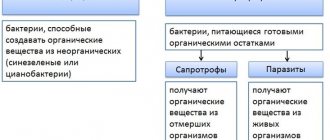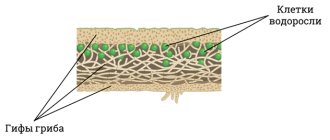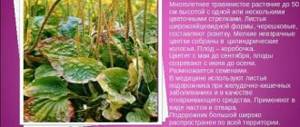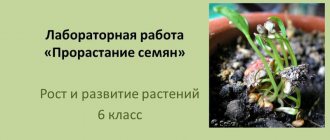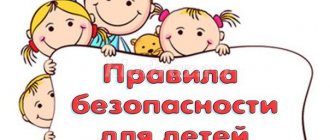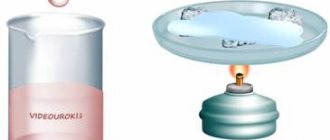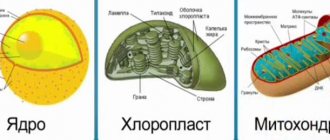Laboratory work in biology in grade 6 “Structure of seeds of dicotyledonous plants”
Laboratory work No. 1 in biology for grade 6 “Study of the structure of the seed of dicotyledonous plants (using the example of beans)”
Target
: study the external and internal structure of the seed of a dicotyledonous plant.
Objectives:
- Expand knowledge about the structure of plant organisms.
— get acquainted with the structural features of seeds of monocotyledonous and dicotyledonous plants. — Form an idea of a seed as a generative organ of a flowering plant. — Reveal the importance of seeds in plant life. Equipment: hand magnifying glass, dissecting needle, dry and swollen bean seeds. Theoretical part
Once in favorable conditions, the seed germinates. In this case, a root first appears from the seed, then a small shoot. Such a young plant is called a seedling. After some time, it develops leafy shoots, and later flowers, fruits and seeds. In other words, a new plant grows from the seed, very similar to the mother one. The seed is considered the organ of sexual reproduction of the plant. Outside, the seeds have a dense covering - a peel. The main function of the seed coat is to protect the seed from damage, drying out, penetration of pathogens and from premature germination. In some plants the seed coat is dense but thin, in others it is woody, thick and very hard (plum, almond, grape, etc.). There is a scar on the peel - a mark from the place where the seed is attached to the wall of the fruit. Next to the hilum there is a small hole - the spermatic opening. Through the seed entrance, water penetrates into the seed, after which the seed swells and germinates. The skin is difficult to remove from dry seeds. But when it takes in water through the spermatic opening and swells, the peel will burst, it can be easily removed, and then the internal structure of the seed will be revealed. Inside the seed, under the skin, is an embryo - a small new plant. In some plants (beans, pumpkin, apple tree, etc.) the embryo is large, and it can be seen if you remove the skin from the seed. In others (pepper, tricolor violet, lily of the valley, onion, etc.), the embryo is very small, it lies in the seed, surrounded by endosperm (from the Greek endon - “inside”, sperm - “seed”) - special cells that contain a lot reserve nutrients. In such seeds, the skin does not surround the embryo, but the endosperm, inside which is the plant embryo. Endosperm is the storage tissue of the seed. The endosperm is represented by large cells, entirely filled with nutrients in the form of starch, proteins and various oils. All these substances serve as the embryo’s first source of nutrition during seed germination. The embryo of a new plant in the seed has two clearly distinguishable parts: the embryonic shoot and the embryonic root. The embryonic shoot is represented by an embryonic stem, cotyledons (first leaves) and an embryonic bud. For example, beans, pumpkins, apple trees and cucumbers always have two large fleshy cotyledons in the embryo, while wheat, corn, tulips and lilies of the valley have only one cotyledon.
Practical part
Progress:
1. Examine the dry and swollen bean seeds. Compare their sizes and external shape. 2. Take a bean seed and examine it with the naked eye and using a magnifying glass. Find the scar - the place where the seed was attached to the wall of the fruit and the micropyle - the hole through which water and air penetrate into the seed. 3. Using a dissecting needle, remove the shiny, dense skin from the swollen seed. 4.Find the seed embryo. Study its structure. Consider the parts of the embryo: two cotyledons, an embryonic root, a stem and a bud. 5. Determine which part of the bean seed contains reserve nutrients. Task 1. Draw the external structure of the seed from the hilum side and label its parts. Task 2. Draw the structure of a bean seed (Figure 1), label its parts. Task 3. Look at the diagram of the structure of the seed of a monocotyledonous plant (see the textbook figure). Find the main parts of the embryo: root, stalk, cotyledon (embryo leaf), bud, scutellum. Task 4. Sketch the appearance of the grain (Figure 2).
Rice. 1. The structure of a bean seed Task 5. Compare how the structure of the seeds of dicotyledonous plants differs from the seeds of monocotyledonous plants? What are their similarities? Write down your conclusion in your notebook. Task 6. Think and write down: what importance do seeds have in the life of plants? Rice. 2. The structure of the seed of monocotyledonous plants - wheat grain
Conclusion
: During the work _________________________________________________.
Features of the structure of dicotyledonous seeds
Typical dicot seeds are peas and beans. Under the thick skin they have two large symmetrical cotyledons, which, when germinated, are carried into the light with the shoot, and soon dry up.
Rice. 3. The structure of the seed of a dicotyledonous plant.
The embryo is sandwiched between the cotyledons.
The skin of beans and peas is dense. The seed can remain dormant for a long time. But, when placed in a humid environment, water penetrates through the micropyle and the seed swells. The cells of the embryo begin to divide and the root breaks through the skin.
How do plants develop?
After the pollination process, plants produce fruits that store the seeds. Once in the ground, they germinate and thus give life to new plants.
For this to happen, there must be suitable conditions:
- Water . Penetrating inside the seed, water causes it to swell. Under pressure, the seed skin bursts and a small root appears, which quickly becomes fixed in the soil and begins to absorb nutrients from it. After a while, a stem with a leaf begins to grow, and soon a new young plant appears above the ground.
Rice. 3. Young sprout.
- Oxygen . Germinating seeds need not only water, but also oxygen. If they find themselves under a thick layer of water, where very little valuable gas penetrates, they will not be able to germinate.
- Warm . Even if two important conditions are met - the presence of water and oxygen, but there is no heat, the seed will not be able to germinate. That is why plant reproduction occurs in the spring, when the snow melts and the soil has time to warm up properly.
During the classes
I. Organizational moment
Including children in activities. Selection of content area. Organization of student self-determination regarding the known norm of activity in the lesson.
II. Updating knowledge
1) updating of knowledge, sufficient for the “discovery of new knowledge”
No beginning, no end, no back, no face. Everyone knows: both young and old, That she is a huge ball. (planet Earth)
Teacher Questions:
–
Why is there life on Earth? (Special conditions have arisen: water, soil, air.)
– What would happen on Earth if it flew around the Sun in a different orbit? (The celestial bodies that are more distant from the Sun receive too little solar heat, they are very cooled, and those that are closer to the Sun are too hot for living beings.)
– What is the main condition for the emergence and development of life on Earth? (The Earth has an air and water shell. Air and water became the main conditions for the emergence and development of life on Earth.)
– What do all living things on Earth need? (In heat, light, water and air.)
– What is the name of the science that studies living nature? (Biology - “BIOS” - life, “LOGOS” - teaching.)
– How did the science of plants – botany – appear? (Ancient people, collecting plants, accumulated knowledge about them.)
III. Formulation of the problem
SPRING is the sun, SPRING is joy, Spring is life.
The evil blizzard has passed away, The night has become shorter than the day. A warm wind blows from the south, Drops fall, ringing... They lay down in the blizzard fields in their white beds. And SPRING is coming everywhere, driving winter away from the yard. (G. Ladonshchikova)
WATCHING THE FILM “Awakening of Nature from Winter Sleep”, “Thawed Lands”.
It breathes, grows, but cannot walk. (Plant)
IV. “Children’s discovery of new knowledge”
1) involving children in the situation of choosing a method for solving a problem.
–
We decided that it would be clearer if we ourselves observed what happened to the seed under different conditions and determined all the conditions for the germination and development of a plant from a seed. (Method – practical research work).
2) Children solving problems using the chosen method.
PRACTICAL WORK
- "Conditions for the germination of a plant from a seed"
- “Conditions for the development of a plant from a seed”
Goal: to determine under what conditions a seed germinates and under what conditions it does not. (Workbook, p. 34, No. 76, 77.)
Table No. 76.
Observations were carried out over 5 days. The table was filled out daily.
- The seed in a dry napkin did not germinate, no changes.
- The seeds, in a damp cloth and in the warmth, swelled and a root appeared.
- The seeds in a glass of water are swollen and have not sprouted.
- Seeds in the refrigerator in a damp cloth (slightly swollen, not sprouted)
Table No. 77.
Observations were carried out for more than 2 weeks. The table was filled out during the “World around us” lessons, observations were made daily.
- The seed with the root was planted in the soil in cups. The soil is always moist.
- A sprout appeared on the 3rd day, the sprout breaks through the shell and grows upward.
- The plant sheds its seed coat.
- The first leaves appear on the new plant.
- The grown plant in the closet is yellow and frail.
Students talk about personal experiences, observations, show drawings, photographs, and sprouted plants.
3) Fixing a new algorithm of new knowledge)
Filling out the diagram - drawing by students individually and by the teacher on the board.
CONCLUSION: For the germination and development of a plant from a seed, MOISTURE, HEAT, AIR, LIGHT, and MINERALS are needed.
PUZZLES
- I crawled out of the little barrel, took root and grew up. (Rostock)
He is without arms, He is without legs, He was able to break out of the ground. (Rostock)
The cramped house split into two halves, and beads - pellets - fell into the palms. (Seeds of peas, beans, beans, acacia, colza, radish, turnip...)
HOW DO SEEDS GROW?
Each seed contains a tiny plant embryo inside its tough outer shell. In order for it to grow, each seed contains a supply of nutrients. The most important thing that is necessary for the germination of the embryo is water and warmth. Therefore, the young shoot always heads towards the sunlight. And the root grows down into the soil.
The growth of a seed begins like this: water penetrates into the seed shell, and it swells. The root breaks through the shell first and begins to grow downwards. Then a sprout shoots up. The root grows thin, hair-like shoots that draw water and minerals from the soil. After the sprout makes its way to the surface of the soil, green leaves appear on it.
V. Primary consolidation. CLUB Whychek
"I am a researcher."
- Children's independent solution of typical tasks.
- Speaking out loud how to solve a problem.
1) Defense of the research work “How do plants grow and why do they grow upward?” –
SOURCES OF OBTAINING INFORMATION (BOOK, COMPUTER, ADULTS, ENCYCLOPEDIA, ETC.)
2) Defense of the research work “Pomelo. What kind of plant is this? How to grow it? –
(The plant is grown from the seed of a pomelo, the fruit of a citrus plant is a pomelo).
VI. Creating a Success Situation
Additionally:
Test “Development of a plant from a seed” (It is possible to test in the next lesson)
1) Children’s independent solution of standard tasks.
Self-test.
2) Creating a situation (The girl’s tangerine shoot died, she forgot to water it);
Self-esteem. The children are happy with the work.
– What did you like most?
– Now children will be able to properly plant flower seedlings during a technology lesson for a school flower bed.
General features of seed structure
The seed has the following parts:
- embryo;
- endosperm;
- testa.
The embryo develops from the zygote - this is the main part of the seed. The embryo is clearly visible in leguminous plants (beans, peas, beans). It looks like a miniature plant and has:
TOP 3 articles that are read along with this
- 1. Angiosperms
- 2. Seed germination
- 3. Class Monocots
- spine;
- the escape;
- cotyledons.
The radicle is the first to begin growing when the seed germinates and forms the main root. A shoot is a rudimentary stem with a bud. The cotyledons are attached to the shoot and are the first pair of leaves of the future plant.
The endosperm consists of large cells of storage tissue. Its purpose is to nourish the embryo until it switches to independent nutrition through photosynthesis.
The seed coat protects the seed from drying out, damage and premature germination. To allow water to penetrate inside the seed, the skin has a hole (micropyle).
The heaviest seed is the Seychelles nut seed, its weight reaches 25 kg.
Features of the structure of monocot seeds
The cotyledons of monocots are called scutellum. Its function is to transfer nutrients from the endosperm to the embryo. The endosperm occupies most of the seed.
Rice. 2. The structure of the seed of a monocot plant.
Differences in seed structure are not all that separate the two classes of flowering plants. Dicotyledons and monocotyledons have different leaf venation, structure of the root system and stem.
